Exhibit 99.2

3 Q 19 Earnings Presentation October 30, 2019 Presented by: Anthony G. Petrello Chairman, President, & Chief Executive Officer William J. Restrepo Chief Financial Officer
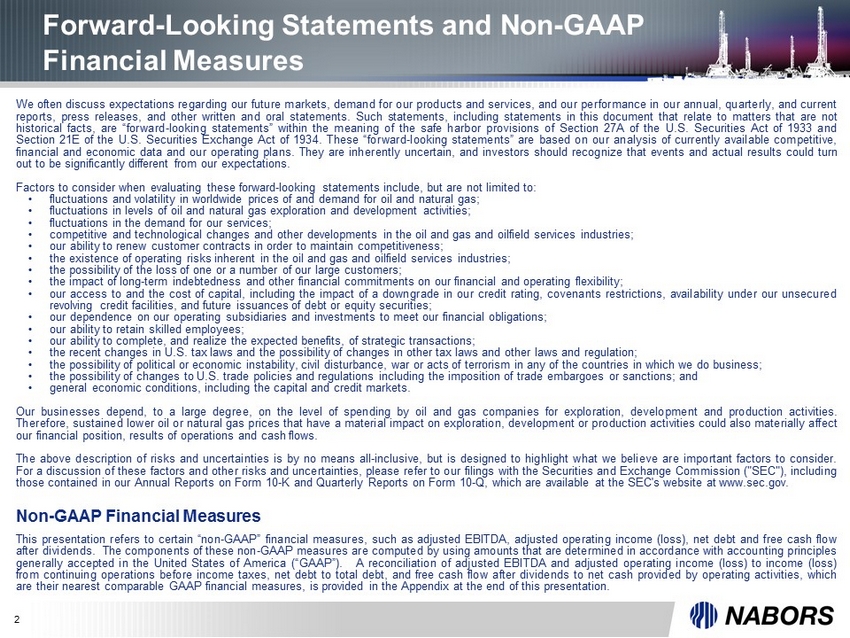
2 We often discuss expectations regarding our future markets , demand for our products and services, and our performance in our annual, quarterly, and current reports, press releases, and other written and oral statements . Such statements, including statements in this document that relate to matters that are not historical facts, are “forward - looking statements” within the meaning of the safe harbor provisions of Section 27 A of the U . S . Securities Act of 1933 and Section 21 E of the U . S . Securities Exchange Act of 1934 . These “forward - looking statements” are based on our analysis of currently available competitive, financial and economic data and our operating plans . They are inherently uncertain, and investors should recognize that events and actual results could turn out to be significantly different from our expectations . Factors to consider when evaluating these forward - looking statements include, but are not limited to : • fluctuations and volatility in worldwide prices of and demand for oil and natural gas ; • fluctuations in levels of oil and natural gas exploration and development activities ; • fluctuations in the demand for our services ; • c ompetitive and technological changes and other developments in the oil and gas and oilfield services industries ; • o ur ability to renew customer contracts in order to maintain competitiveness ; • t he existence of operating risks inherent in the oil and gas and oilfield services industries ; • the possibility of the loss of one or a number of our large customers ; • the impact of long - term indebtedness and other financial commitments on our financial and operating flexibility ; • o ur access to and the cost of capital , including the impact of a downgrade in our credit rating, covenants restrictions, availability under our unsecured revolving credit facilities, and future issuances of debt or equity securities ; • o ur dependence on our operating subsidiaries and investments to meet our financial obligations ; • our ability to retain skilled employees ; • our ability to complete, and realize the expected benefits, of strategic transactions ; • the recent changes in U . S . tax laws and the possibility of changes in other tax laws and other laws and regulation ; • the possibility of political or economic instability, civil disturbance, war or acts of terrorism in any of the countries in which we do business ; • t he possibility of changes to U . S . trade policies and regulations including the imposition of trade embargoes or sanctions ; and • general economic conditions, including the capital and credit markets . Our businesses depend, to a large degree, on the level of spending by oil and gas companies for exploration, development and production activities . Therefore, sustained lower oil or natural gas prices that have a material impact on exploration, development or production activities could also materially affect our financial position, results of operations and cash flows . The above description of risks and uncertainties is by no means all - inclusive, but is designed to highlight what we believe are important factors to consider . For a discussion of these factors and other risks and uncertainties, please refer to our filings with the Securities and Exchange Commission ("SEC"), including those contained in our Annual Reports on Form 10 - K and Quarterly Reports on Form 10 - Q, which are available at the SEC's website at www . sec . gov . Non - GAAP Financial Measures This presentation refers to certain “non - GAAP” financial measures, such as adjusted EBITDA, adjusted operating income ( loss), net debt and free cash flow after dividends . The components of these non - GAAP measures are computed by using amounts that are determined in accordance with accounting principles generally accepted in the United States of America (“GAAP”) . A reconciliation of adjusted EBITDA and adjusted operating income (loss) to income (loss) from continuing operations before income taxes, net debt to total debt, and free cash flow after dividends to net cash provided by operating activities, which are their nearest comparable GAAP financial measures, is provided in the Appendix at the end of this presentation . Forward - Looking Statements and Non - GAAP Financial Measures

3 Recent Company Highlights Increased U.S. Drilling average daily margins to $12,400 from $12,061 in 2Q • Modest increase in Lower 48 daily margins to $10,231 from $10,222 in 2 Q as industry rig count declines by 11% International deployments: • Successfully deployed two impactful rigs in 3Q, Argentina (1) and Kazakhstan (1) • Pending deployments in Kuwait (1), Mexico (2) and Saudi Arabia (1) Sequential adjusted EBITDA improvement in International and Drilling Solutions Continued growth in penetration of ROCKit ® Pilot and Navigator TM Deployed the first unit of the next - generation Canrig ® Sigma topdrive

4 Canrig ® Sigma topdrive • New design, 1st unit deployed • 500 Ton, 1500 Horsepower • Incorporates direct drive • Fewer moving parts • Reduced maintenance • Built - in Casing Running System

5 Financial Overview

6 Financial Summary (1) See reconciliations in the Appendix (2) Diluted Earnings (Losses) Per Share from continuing operations ($000 except EPS) 3Q18 4Q18 1Q19 2Q19 3Q19 Operating Revenues $779,425 $ 782,080 $ 799,640 $771,406 $758,076 Adjusted EBITDA (1) $200,960 $ 201,619 $ 196,996 $198,407 $207,034 Adjusted Operating Income (Loss ) (1) ($7,557) ($ 25,024) ($ 13,395) ($ 19,912) ($14,523) Income (Loss) from Continuing Operations before income taxes ($ 83,221) ($ 143,594) ($ 73,577) ($ 181,403) ($ 75,885) Diluted EPS (2) (0.31) (0.55) (0.36) (0.61) ( 0.37)
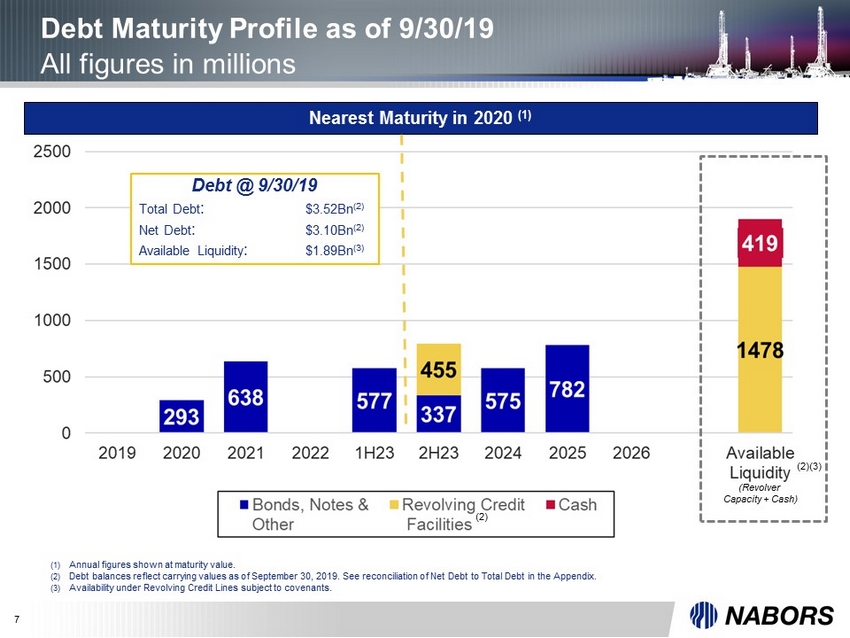
Debt Maturity Profile as of 9/30/19 All figures in millions (1) Annual figures shown at maturity value. (2) Debt balances reflect carrying values as of September 30, 2019. See reconciliation of Net Debt to Total Debt in the Appendix. (3) Availability under Revolving Credit Lines subject to covenants. Nearest Maturity in 2020 (1) Debt @ 9/30/19 Total Debt : $ 3.52Bn (2) Net Debt : $ 3.10Bn (2) Available Liquidity : $1.89Bn (3) (Revolver Capacity + Cash) (2) (2)(3) 7
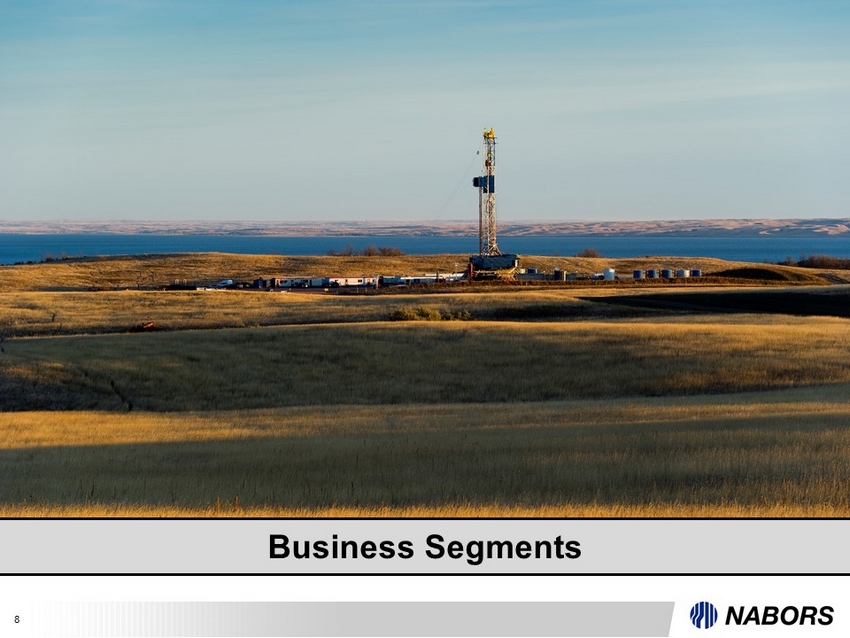
8 Business Segments

Rig Fleet (1) 3Q19 Average Rigs Working Average Utilization U.S. Lower 48 AC ≥ 1500HP 119 98 87% AC Others 63 8 13% SCR Rigs 8 2 22% U.S. Lower 48 Total 190 108 67% U.S. Offshore 12 3 25% Alaska 16 3 20% Canada 41 8 20% International 149 88 58% Total Fleet 408 210 54% 9 3 Q19 Rig Utilization & Availability (1) As of September 30, 2019 Note : Subtotals may not foot due to rounding
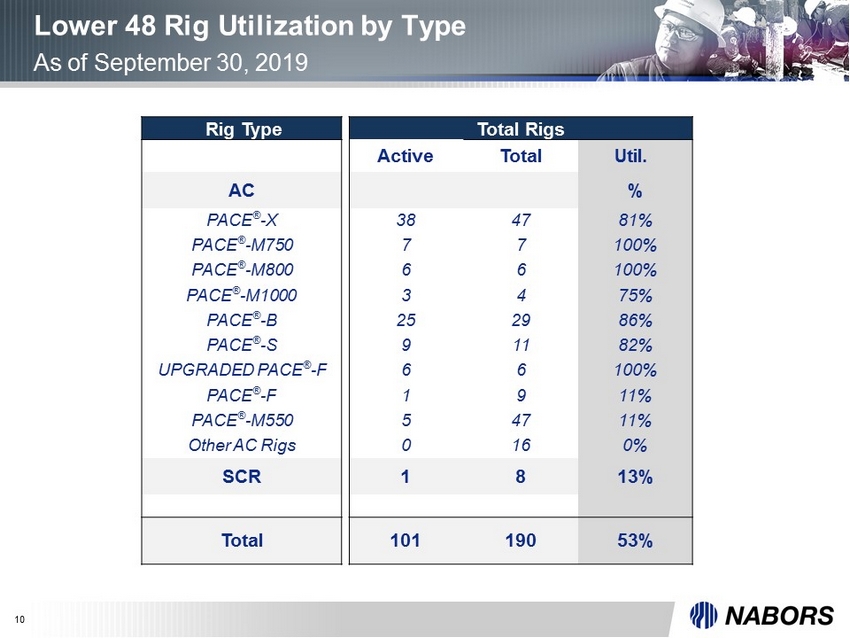
10 Lower 48 Rig Utilization by Type As of September 30, 2019 Rig Type Total Rigs Active Total Util. AC % PACE ® - X 38 47 81% PACE ® - M750 7 7 100% PACE ® - M800 6 6 100% PACE ® - M1000 3 4 75% PACE ® - B 25 29 86% PACE ® - S 9 11 82% UPGRADED PACE ® - F 6 6 100% PACE ® - F 1 9 11% PACE ® - M550 5 47 11% Other AC Rigs 0 16 0% SCR 1 8 13% Total 101 190 53%

11 Please refer to the disclaimers on slides 2 and 3 of the presentation deck. U.S. 108 Kazakhstan 6 Venezuela 3 Mexico 2 Saudi Arabia 42 Oman 4 Algeria 2 Colombia 12 Canada 9 India 2 Argentina 10 Russia 3 Kuwait 2 Total = 205 Nabors Drilling Operations As of September 30, 2019
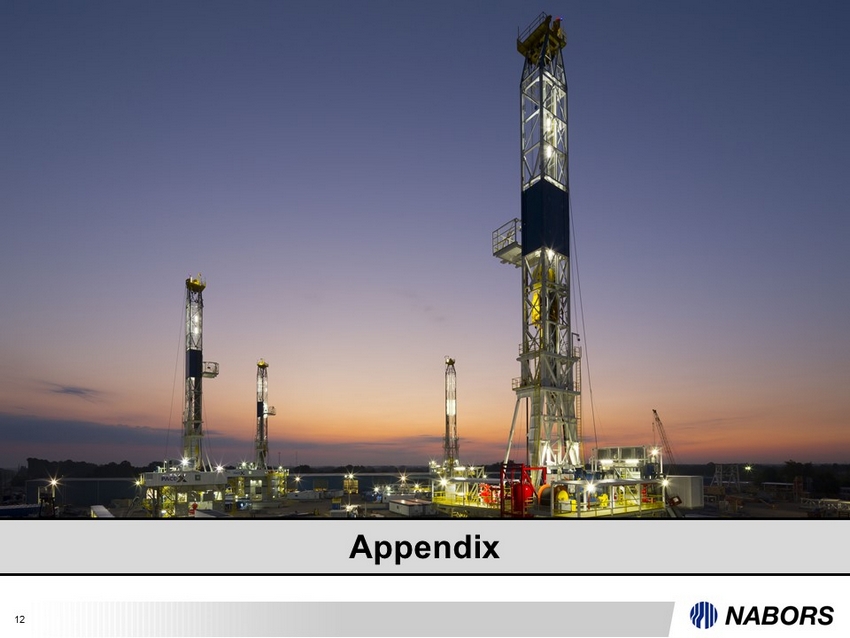
12 Appendix

13 Rig Margins & Activity (1) Margin = gross margin per rig per day for the period. Gross margin is computed by subtracting direct costs from operating revenues for the period. 3Q18 4Q18 1Q19 2Q19 3Q19 Margin (1) Avg. Rigs Working Margin (1) Avg. Rigs Working Margin (1) Avg. Rigs Working Margin (1) Avg. Rigs Working Margin (1) Avg. Rigs Working U.S. Drilling $ 10,540 111.6 $ 11,428 117.3 $12,350 120.9 $12,061 122.2 $ 12,400 114.1 Canada Drilling 5,352 17.9 6,492 18.3 6,055 16.3 3,764 7.4 3,799 7.7 International Drilling 15,003 96.0 13,527 88.0 12,622 89.7 12,610 88.6 13,739 87.7

14 Reconciliation of Adjusted EBITDA to Income (Loss) from Cont. Operations Before Income Taxes Adjusted operating income (loss) represents income (loss) from continuing operations before income taxes, interest expense, e arn ings (losses) from unconsolidated affiliates, investment income (loss ), impairments and other charges and other, net. Adjusted EBITDA is computed similarly, but also excludes depreciation and amortization expenses. In addition, adjusted EBITDA and adjusted operating income (loss) exclude ce rta in cash expenses that the Company is obligated to pay. Each of these non - GAAP measures has limitations and therefore should not be used in isolation o r as a substitute for the amounts reported in accordance with GAAP. However, management evaluates the performance of its operating segments and the con sol idated Company based on several criteria, including adjusted EBITDA and adjusted operating income (loss), because it believes that these fin anc ial measures accurately reflect the Company’s ongoing profitability and performance. Securities analysts and investors use these measures as some of the metrics on which they analyze the Company’s performance. Other companies in this industry may compute these measures differently. A reconciliation of adjusted EBITDA and adjusted operating income (loss) to income (loss) from continuing operations before income taxes which is the nearest compara ble GAAP financial measure, is provided in the table below. Three Months Ended September 30, December 31, March 31, June 30, September 30, (In Thousands) 2018 2018 2019 2019 2019 Adjusted EBITDA $200,960 $201,619 $196,996 $198,407 $207,034 Depreciation and Amortization (208,517) (226,643) (210,391) (218,319) (221,557) Adjusted Operating Income (loss) (7,557) (25,024) (13,395) (19,912) (14,523) Earnings (losses) from unconsolidated affiliates 0 0 (5) 0 0 Investment Income (loss) (1,342) (5,458) 9,677 469 (1,437) Interest Expense (51,415) (53,731) (52,352) (51,491) (51,291) Other, net (9,137) (5,369) (19,304) (6,289) (5,005) Impairments and other charges (13,770) (54,012) 1,802 (104,180) (3,629) Income (loss) from continuing operations before income taxes (83,221) (143,594) (73,577) (181,403) (75,885)

15 Reconciliation of Free Cash Flow After Dividends to Net Cash Provided by Operating Activities Free cash flow after dividends represents net cash provided by operating activities less cash used for investing activities a nd cash paid for dividends. Free cash flow is an indicator of our ability to generate cash flow after required spending to maintain or expand our asset b ase and pay dividends. Management believes that this non - GAAP measure is useful information to investors when comparing our cash flows with the cash fl ows of other companies. This non - GAAP measure has limitations and therefore should not be used in isolation or as a substitute for the amount s reported in accordance with GAAP. However, management evaluates the performance of the consolidated Company based on several criteria, in clu ding free cash flow after dividends, because it believes that these financial measures accurately reflect the Company's ongoing profitabilit y a nd performance . Three Months Ended March 31, June 30, September 30, (In thousands) 2019 2019 2019 Net cash provided by operating activities 69,854$ 203,231$ 157,192$ Less: Net cash used for investing activities (144,444) (113,760) (75,496) Less: Dividends to common and preferred shareholders (25,765) (7,940) (7,938) Free cash flow after dividends (100,355)$ 81,531$ 73,758$














